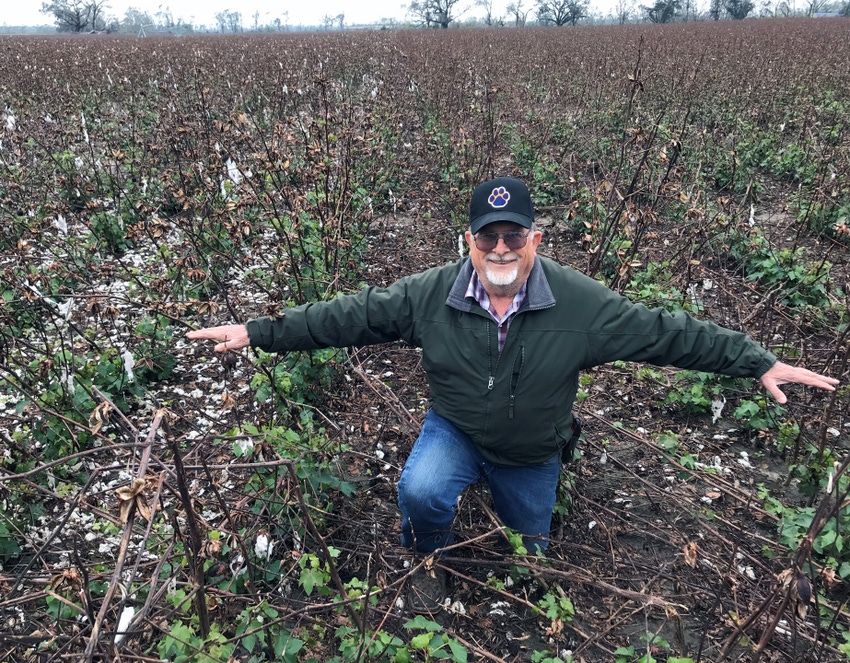
Winter’s first cold front bites through, a bitter one for Southern blood, and Larry Ford walks his cotton field.
There is a lot of cotton in the field, but only whiffs of strands remain twisting on any stalk — except in that one spot right there. There Ford harvested 12 acres and clocked a good 1,500 pounds per acre before Hurricane Michael — in a few hours — efficiently picked the rest. The storm didn’t bother to bale the crop on its way out of Jackson County, where its eye passed over midday Oct. 10, 2018.
Ford, 73, is one of the largest and best-known farmers in the county, and grows 2,200 acres of cotton, about 800 acres of peanuts, several hundred acres of corn, and has a successful cattle business with about 100 mama cows, providing top line F-1 Brahman-Angus females to cattlemen for herd replacement.
(EDITOR’S NOTE: This article is part of series we’ll put forward over the next few weeks. The idea: To travel to Florida one month later, track the eye of Michael as it went over the Panhandle and up into southwest Georgia as a hurricane. We stopped along the way to talk to farmers.)
“All cotton that was defoliated is gone. If it wasn’t defoliated, well, it’s gone, too,” he said.
The later-planted cotton fared somewhat better and will pick in the hundreds of pounds per acre at best. He figures he lost more than 80 percent of his total cotton crop.
“From the cash flow side, from what I anticipated making in cotton this year and what I’m going to get out of it, which is basically an insurance deal, I will probably get 40 percent of what I was planning on making,” Ford said Nov. 15.
The storm folded up his large equipment shelter, which held his planters and diggers and other implements. He has seven pivots laying twisted in fields. Of his 800 acres of planted pines, maybe 100 acres maybe survived the storm in some way, much of it snapped off or laying roots up.
Ford didn’t get much damage to his home. He taped up the large glass windows. He made sure to shape the tape into several crosses. Ford has ridden out many storms of all kinds and has seen many tornadoes come through the region. As Michael hit around mid-morning Oct. 10, he knew it was different. Like gunfire, trees popped and rain drove so hard against his front door that water penetrated through the wood, but things held tight. They were without electricity for three weeks.
Odd Stuff
Strange things and odd coincidences happened during the storm — and after — on Ford’s farm. The storm blew out the windows, part of the roof and broke fluorescent bulbs inside his spacious work barn. Not a surprise. You can look cross-eyed at a fluorescent bulb and break it, but one of those bulbs during the storm got detached, blew out and landed near a well pump some 150 feet away, landing perfectly without breaking.
The storm plucked four anchors from the corners of a small metal shed near his water tanks, spun the shed around and placed it gently back with the door facing the opposite direction as before.
And it seemed the cotton in the bottom of fields, or in low-lying areas, got damaged or stripped away worse than cotton up on hills. Don’t know why. Don’t make sense, he said.
You needed a chainsaw to get anywhere the morning after the storm. Leaving the house, he said he meandered up Hwy 2 to try to get to Malone, but turned around because it was too bad. It took several hours. He came back by the high school in Greenwood trying to work his way back to his main farm headquarters. And when he got there, all three of his grown daughters showed up. “We didn’t plan it or anything. We just happened up all at the same time, and there they were. The whole family pretty much. I thought that was very ironic.”
Ford is uncertain now what 2019 will bring for him, and several questions remain to be answered. He plans to plant something, but might pull back on his cotton acres, and right now what do you do? He was able to get his peanuts in, though buying points were hampered by the storm, and in the last three weeks he can count on one hand the days it hasn’t rained since the storm.
As of the writing of this, Nov. 16, there still was no farm bill, and some cotton growers didn’t know if they should pick what was left of cotton. It cost roughly 100 pounds per acre to pay for harvest. With only hundreds of pounds left, do you pick? And what about the trade mitigation program announced this summer, the deal where cotton growers can receive 6 cents per pound of cotton harvested in 2018 to offset losses due to the tariff spat between the U.S. and China? If you don’t have cotton to pick in 2018, what good is that program?
Around a Table
You take what happens in life, the good and the bad, and you live.
Sitting around a plastic rectangle folding table back on Ford’s farm, Ford leaned forward in his chair, unfolded his arms, smiled and gave a quick jab forward with his finger and said, “You can’t go forward if you keep looking back.”
People who know Ford will tell you he knows what he’s talking about when he says that.
Florida Panhandle agriculture damage, according to a Oct. 30 Florida Department of Agriculture report, includes:
Forestry — $1.3 billion;
Cotton — $50 million;
Cattle — $43 million;
Peanut — $23 million;
Nurseries — $16 million;
Vegetables — $8.6 million;
Dairy — $6.4 million.
About the Author(s)
You May Also Like






